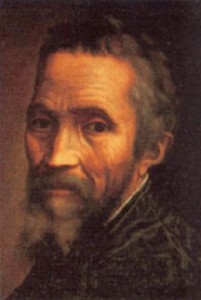 More widely remembered for his sculpture of David and painting the ceiling of the Sistine Chapel, Michelangelo Buonarroti was also a poet and engineer who was born in Tuscany in 1475. His father worked in a governmental position and his mother suffered from various ailments during his early life and died when he was just 6 years old.
More widely remembered for his sculpture of David and painting the ceiling of the Sistine Chapel, Michelangelo Buonarroti was also a poet and engineer who was born in Tuscany in 1475. His father worked in a governmental position and his mother suffered from various ailments during his early life and died when he was just 6 years old.
Michelangelo was interested in painting from a young age and did not take well to his studies when he was sent to Florence to be tutored by Francesco da Urbino the eminent humanist. The city at the time was the centre of art and learning and at the young age of 13 Michelangelo was accepted as an apprentice to one of the premier fresco workshops and was quickly regarded as one of their best students. It was the beginning of a long and industrious career that saw him become one of the great artists of the Renaissance.
The height of Michelangelo’s poetic output took place fairly late in his life between 1532 and 1548 and this work is often overshadowed by his other artistic endeavors. He was judged to be a rather arrogant sculptor and painter but was a little more reticent about his written work that ranged from conventional poetry in his early days to experimentation with more adventurous forms in later life.
Also in his later works, Michelangelo began seriously to explore such poetic staples as love and the approach of death. He was in his fifties at the time and was supposedly struggling with his own homosexuality. A number of his poems are dedicated to Cavalieri, a young man he encountered whilst in Rome and for whom he held a bright and emotional torch, though largely unrequited. Whilst the poems are largely gender neutral it is easy to see the poet’s passion and desire for the person he loved.

Other of Michelangelo’s love poems are thought to be dedicated to marquess Vittoria Colonna with whom he had a long lasting friendship. She is the only woman for whom he wrote and when she died suddenly in 1547, he stopped writing love poetry altogether. By then he was also suffering from illnesses of his own and only wrote a few poems after this time.
Despite his other gifts, Michelangelo is accepted as one of the leading lyric poets of the age, often referred to as the Dante of art, able to bring the vibrancy and imagination of his paintings to the written word.

His poetry is all the more remarkable in that he had been commissioned to paint the Last Judgement on the wall of the Sistine Chapel during his most prolific output of writing. He worked on a number of other projects at the time including the design for the Sforza Chapel and a further Vatican commission for two large frescoes at the Cappella Paolina.
Michelangelo worked up until the later part of his life, leaving several works, such as the sculpture Rondanini Pieta, unfinished. He died three weeks shy of his 89th birthday in 1564 and his body was taken back to Florence where he was interred at the Basilica of Santa Croce.

